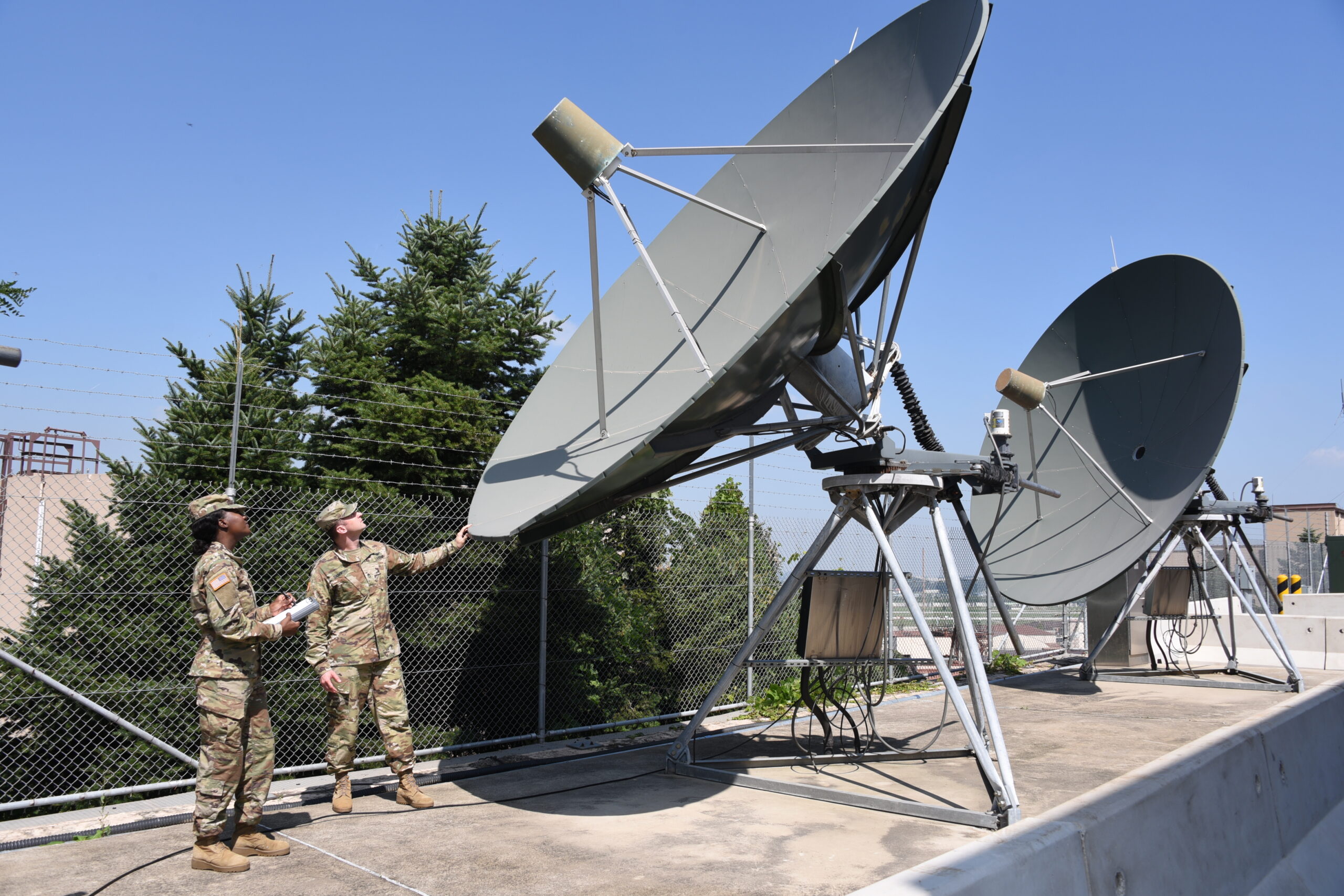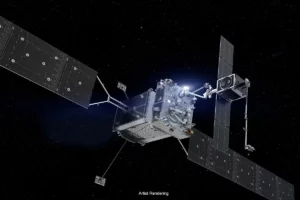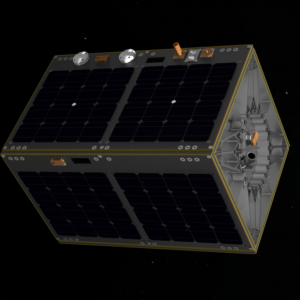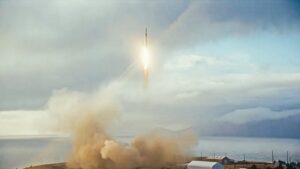
WASHINGTON — The U.S. Army’s top leadership has unveiled new guidance underscoring the vital role of space systems in modern ground warfare and calling for greater investment in space capabilities.
The memo, released Jan. 8, was signed by Army Chief of Staff Gen. Randy George, Army Secretary Christine Wormuth, and Sergeant Major of the Army Michael Weimer. It outlines a vision for enhanced integration of space capabilities across all Army operations and activities.
The memo also contains the Army’s explicit commitment to develop capabilities to interdict, or disrupt, adversaries’ use of space capabilities if necessary to defend U.S. and coalition forces. This means having capabilities to deny enemy forces the use of critical intelligence, surveillance, and reconnaissance platforms orbiting above the battlefield — through electronic warfare or even potential kinetic attacks.
Whereas space has traditionally been seen as playing a supporting role to ground, air, and naval forces, the Army’s latest guidance envisions the potential for space systems themselves to become targets. By developing means to deactivate or disrupt adversary satellites, U.S. forces could undercut rivals’ efforts to monitor and target American assets.
The memo warns that rival militaries have increased the use of space-based surveillance capabilities allowing them to continuously monitor U.S. and allied forces’ movements. As a result, Army units must assume they are perpetually being watched from above and take measures to conceal their activities.
According to the guidance:
- The Army will integrate joint and coalition space capabilities and interdict adversary space capabilities in support of ground force commanders.
- Successful operations in and through the space domain will be critical to our success.
- Commanders must understand that space capabilities start and end on the ground and be fully aware of their importance in planning and operations.
- We will be operating under constant surveillance, and must invest in the knowledge and forces to counter threat space systems and enable our own space systems.
- The Army must have the resources and expertise to integrate friendly joint coalition and commercial space capabilities, support of all army functions, including positioning, navigation, and timing; deep sensing; beyond line of communications; environmental monitoring; space domain awareness and geospatial information.
- The Army needs expertise and resources to interdict adversary space capabilities by delivering necessary fires and effects to protect friendly forces from observation and targeting.
‘Second nature’
“Integrating joint and Army space capabilities into the operations process must become second nature to commanders at every echelon,” George said in a statement. “We accomplish this by incorporating these capabilities into training, education, experiments and exercises.”
The Space and Missile Defense Center of Excellence will work closely with other organizations across the Army to “ensure the vision is incorporated across the institutional Army,” George added.
The Army’s new guidance aligns with the Department of Defense’s emphasis on multi-domain operations — employing all available combat power from each domain: air, sea, space, cyber, and the electromagnetic spectrum.
The memo suggests a recognition of rapid advancements in space technology by peer militaries like China and Russia. The Chinese firm Changguang Satellite Technology, or CGST, now has 108 remote sensing satellites in orbit and aims to expand its Jilin-1 constellation to 300 satellites by 2025.
The news agency Agence France-Presse last year reported that Russian mercenary group Wagner in 2022 signed a contract with CGST to acquire two satellites and use their images, aiding its intelligence work in Russia’s invasion of Ukraine.
- SEO Powered Content & PR Distribution. Get Amplified Today.
- PlatoData.Network Vertical Generative Ai. Empower Yourself. Access Here.
- PlatoAiStream. Web3 Intelligence. Knowledge Amplified. Access Here.
- PlatoESG. Carbon, CleanTech, Energy, Environment, Solar, Waste Management. Access Here.
- PlatoHealth. Biotech and Clinical Trials Intelligence. Access Here.
- Source: https://spacenews.com/u-s-army-issues-new-guidance-on-the-use-of-space-for-ground-warfare/
- :has
- :is
- 2022
- 2025
- 300
- a
- above
- accomplish
- acquire
- across
- activities
- added
- advancements
- agency
- aims
- AIR
- Aligns
- All
- Allowing
- also
- American
- and
- ARE
- Army
- AS
- Assets
- assume
- At
- Attacks
- available
- aware
- awareness
- Battlefield
- BE
- become
- been
- being
- Beyond
- by
- calling
- capabilities
- Center
- Center of Excellence
- chief
- China
- chinese
- chinese firm
- Christine
- closely
- coalition
- combat
- commercial
- commitment
- Communications
- constant
- contains
- continuously
- contract
- could
- Counter
- critical
- cyber
- deep
- Defense
- delivering
- Department
- develop
- developing
- Disrupt
- domain
- each
- Education
- effects
- efforts
- Electronic
- emphasis
- employing
- enable
- end
- enhanced
- environmental
- envisions
- Even
- Every
- Excellence
- Expand
- experiments
- expertise
- fires
- Firm
- For
- Force
- Forces
- friendly
- from
- fully
- functions
- Gen
- George
- greater
- Ground
- Group
- guidance
- Have
- having
- HTTPS
- if
- images
- importance
- in
- Including
- Incorporated
- incorporating
- increased
- information
- Institutional
- integrate
- integration
- Intelligence
- into
- invasion
- Invest
- investment
- issues
- IT
- ITS
- Jan
- joint
- jpg
- knowledge
- latest
- Leadership
- like
- Line
- major
- means
- measures
- Michael
- militaries
- Modern
- Monitor
- monitoring
- movements
- must
- Nature
- Navigation
- necessary
- needs
- New
- news
- now
- observation
- of
- on
- operating
- Operations
- or
- Orbit
- orbiting
- organizations
- Other
- our
- outlines
- own
- peer
- planning
- Platforms
- plato
- Plato Data Intelligence
- PlatoData
- playing
- positioning
- potential
- power
- process
- protect
- rapid
- recognition
- released
- remote
- Resources
- result
- Rival
- Role
- Russia
- russian
- s
- Said
- satellite
- satellites
- SEA
- Second
- secretary
- seen
- signed
- Space
- space-based
- Spectrum
- Staff
- start
- success
- Suggests
- support
- Supporting
- surveillance
- Systems
- Take
- Target
- targeting
- targets
- Technology
- that
- The
- their
- Them
- themselves
- These
- they
- this
- threat
- Through
- timing
- to
- top
- traditionally
- Training
- two
- u.s.
- Ukraine
- under
- understand
- units
- unveiled
- use
- vision
- vital
- Warns
- was
- will
- with
- Work
- year
- zephyrnet









